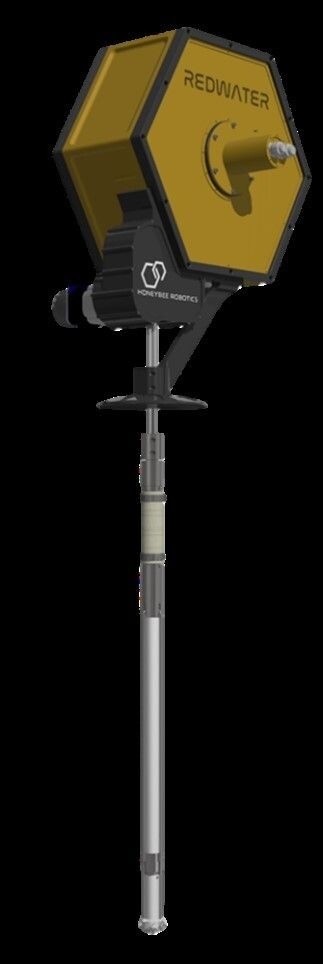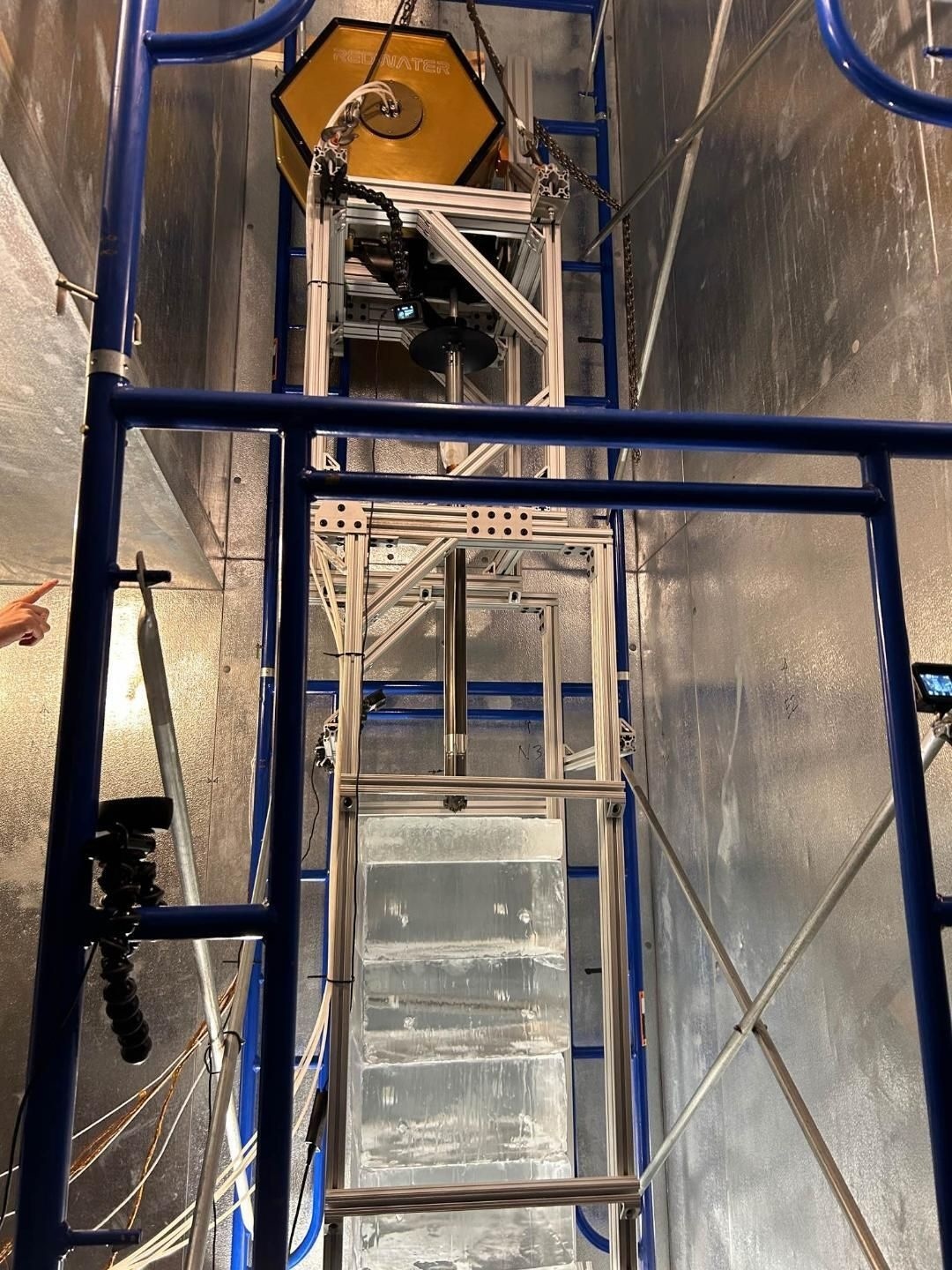26.03.2024
"Just as getting rock samples can provide clues to Mars' early history, ice will give us clues to Mars' recent history."

Drilling down deep for ice on Mars via RedWater technology. (Image credit: Honeybee Robotics)
Things are looking up for digging deep on Mars. Progress is palpable on how best to extract subsurface ice to generate drinkable water, rocket fuel and other useful resources on the Red Planet.
But boring down from the topside of Mars to reach available icy reservoirs is no slam dunk.
Tackling that challenge is the company Honeybee Robotics, which calls its approach the RedWater concept.

Honeybee Robotics' ice drilling hardware for Mars encompasses coiled tubing and the "RodWell" method. (Image credit: Honeybee Robotics)
"RedWater has proven to be the right architecture for deep drilling on Mars," said Kris Zacny, vice president of the exploration technology group at Honeybee Robotics in Altadena, California.
Zacny said that RedWater can serve dual purposes, drilling for scientific exploration and water mining. "It's a win-win. We are at a position where this technology can be infused into [the] next Mars missions," he told Space.com.
Recent revelations about subsurface water ice on the Red Planet mesh well with RedWater.
Glacier ice
Over the years, data gathered by Mars orbiters has revealed that a third of the Martian surface contains ice near the surface, as well as more deeply buried ice sheets.
For example, earlier this year, observations by the European Space Agency's Mars Express probe suggested that layers of water ice stretch several miles below ground in some places on the planet.
Adding to the Mars ice story is this month's report at the 55th Lunar and Planetary Science Conference of a previously unseen volcano.
The new research speculates that, beneath that greatly eroded feature, glacier ice is likely still present, preserved near the surface in a relatively warm equatorial region on Mars.
End-to-end testing

The RedWater system undergoes end-to-end testing in Honeybee Robotics' cold chamber to simulate the super-cold conditions on Mars. (Image credit: Honeybee Robotics)
Meanwhile, Honeybee technologists have recently completed end-to-end testing of a RedWater system in the company's cold chamber, said Joey Palmowski, a systems engineer at the company.
That work was undertaken through a NASA Next Space Technologies for Exploration Partnerships (NextSTEP-2) grant, Palmowski told Space.com.
The RedWater system utilizes two proven terrestrial technologies, already put into action in support of polar operations in both Greenland and Antarctica. They are coiled tubing that unspools from the surface into underlying ice, and what's termed the Rodriguez Well, or "RodWell" concept.
RodWell is a method of melting a well in subsurface ice and pumping the liquid water to the surface.
To cut to the chase: Water ice in the form of debris-covered glaciers or ice sheets, perhaps hundreds of meters thick, has been detected and mapped in the mid-latitudes of Mars. That's a favorable spot for a future human expeditionary outpost.
SWIM team
Nathaniel Putzig is associate director and senior scientist at the Planetary Science Institute's office in Lakewood, Colorado.
As co-lead of the Subsurface Water Ice Mapping (SWIM) on Mars project team, Putzig and colleagues are busy charting the location and depth of mid-latitude ice on Mars.
They're now wrapping up a third phase of the SWIM work, which explicitly aimed to help establish targeting priorities for the prospective International Mars Ice Mapper (I-MIM) mission concept.
Ice-scouting

Roughly a third of Mars has ice just below the planet's surface. Many impact craters in the mid-latitudes of the Red Planet are filled with smooth material that is likely ice covered with some dirt. (Image credit: NASA/JPL-Caltech/University of Arizona)
A radar-carrying orbiter, the I-MIM is a projected NASA undertaking in partnership with the Italian space agency, the Japan Aerospace Exploration Agency (JAXA), and the Canadian Space Agency to develop an ice-scouting Mars orbiter.
I-MIM's key goal is to characterize the extent and volume of water ice in the mid- and low-latitude regions of the planet.
Putzig said he senses that NASA and the other international partners are anxious to pursue the I-MIM mission.
Nevertheless, there has been significant budget uncertainty regarding the endeavor, Putzig observed, certainly on the NASA side and perhaps with other agencies as well.
"This makes it difficult for the international partners to finalize their agreements and begin actively designing and building the mission hardware and instruments," Putzig noted.
Wanted: lateral and vertical data
There are uncertainties within present-day datasets, Putzig said, so more research — and especially new orbital radar sounding capabilities — are needed at Mars.
Once in hand, that information can definitively identify and characterize buried ice at landing-site scales for broad regions across the mid-latitudes of Mars, Putzig added.
"That said, one could in principle send landed missions to higher latitudes or to locations where fresh impacts have exposed ice and be assured of encountering ice in the subsurface using a drill without first acquiring that additional data," said Putzig. "However, even for such locations, the lateral and vertical extent and concentration of the ice will remain poorly constrained without new instruments."
Hard facts

Artist's illustration of NASA's Phoenix Mars lander mission, which in 2008 scooped up soil and probed for ice in the Martian arctic. (Image credit: NASA
Drilling even 1 meter (3.3 feet) into ice can be difficult, explained Isaac Smith, an associate professor at York University in Toronto, Ontario. He's also a senior scientist at the Planetary Science Institute, headquartered in Tucson, Arizona.
Such drilling on Earth requires loads of thermal or electrical power and a lot of human power. "It's especially hard when the ice is much colder than minus 40 degrees Celsius (minus 40 degrees Fahrenheit), like all ice on Mars," Smith said.
That was found to be the case with the NASA Phoenix Mars lander mission in 2008, said Smith. The legged stationary spacecraft plopped down on the planet farther north than any previous mission, at a latitude equivalent to that of northern Alaska, then scooped up Martian soil and checked for — and found — water ice.
"That ice-cemented soil [at the Phoenix lander locale] is really hard to dig in, but anyone who lives in Canada during winter knows not to go digging in a backyard when the ground is frozen," Smith pointed out.
Frozen in time
Carefully sampling any ice on Mars would yield a bonanza of science returns, Smith said.
"Polar ice can give you a detailed record of climate history; mid-latitude ice can become a resource for future space exploration and is the next frontier for seeking life on Mars," Smith advised. "Just as getting rock samples can provide clues to Mars' early history, ice will give us clues to Mars' recent history."
All good news, but reaching depths of tens of meters or more is a big task, Smith said. Doing so is very energy intensive, he said, and requires a lot of human intervention, even on Earth.
"For the foreseeable future, it will have to be done by robots on Mars, probably over long periods, requiring extra levels of robustness, which adds cost, and some power source that we don't have yet," Smith said. "It's feasible in the long term, and Honeybee Robotics is probably the company to build it."
Quelle: SC
